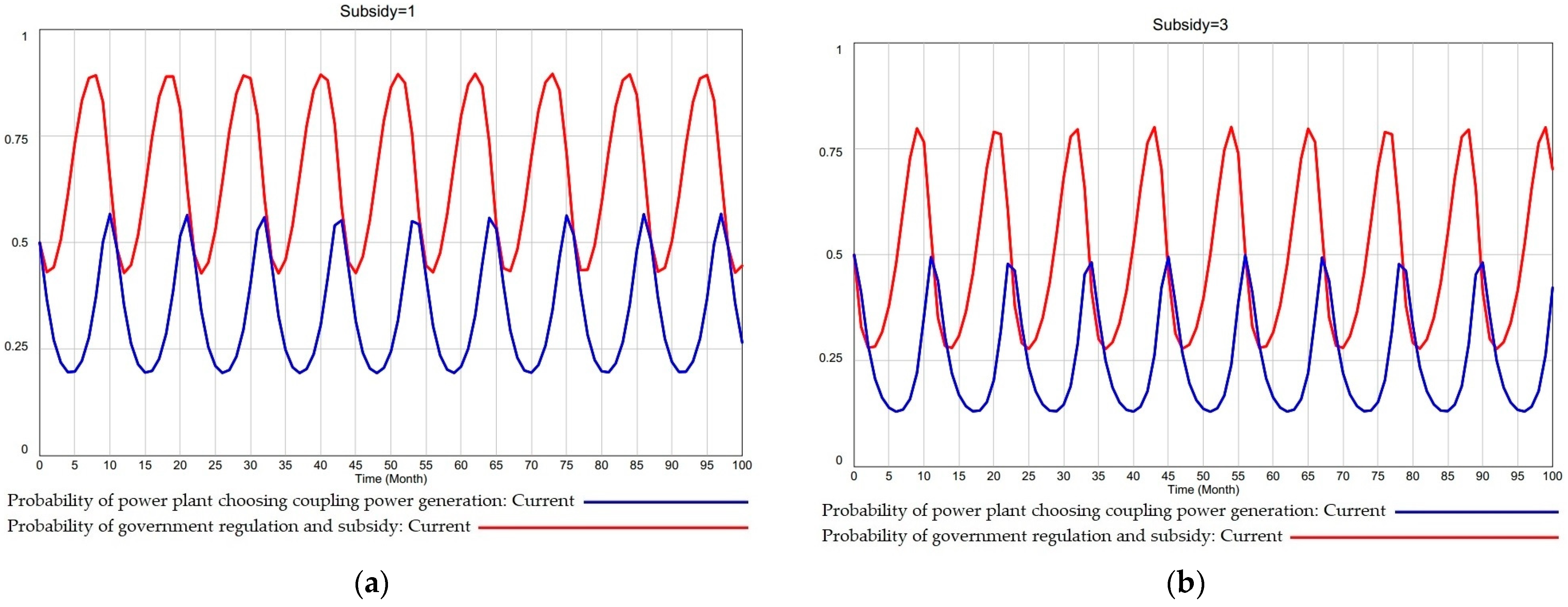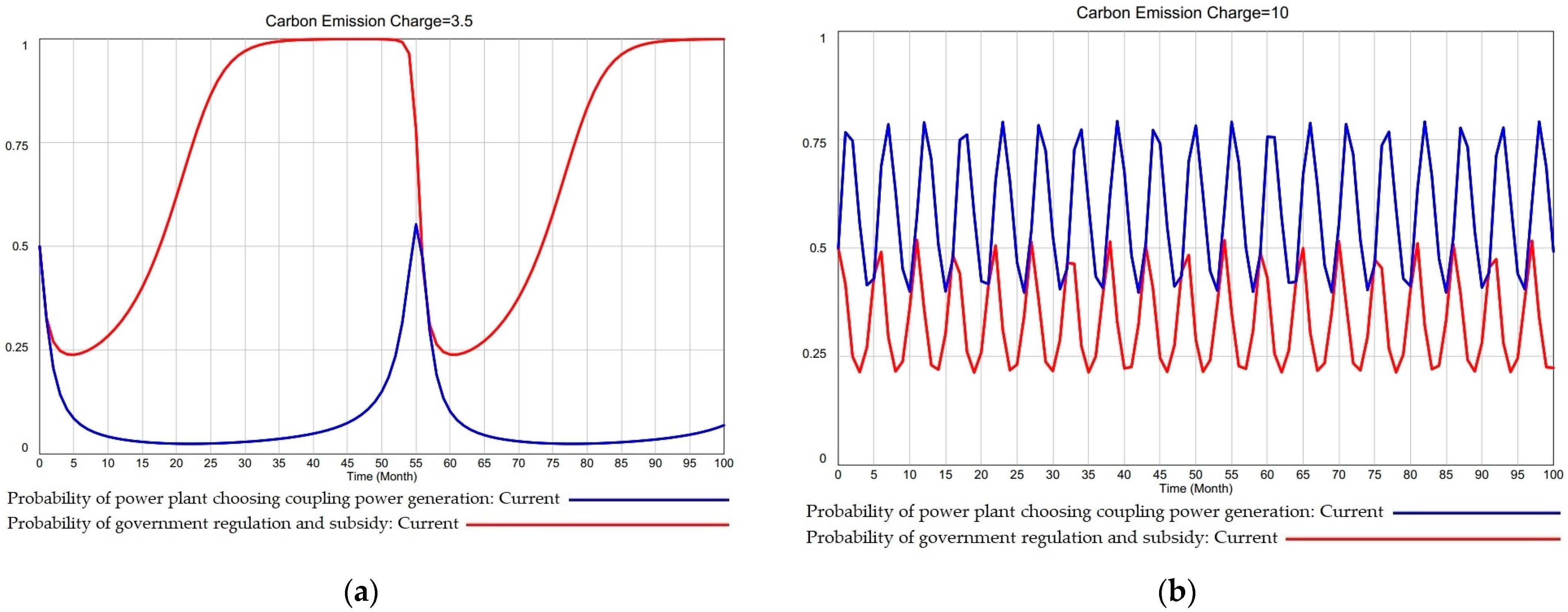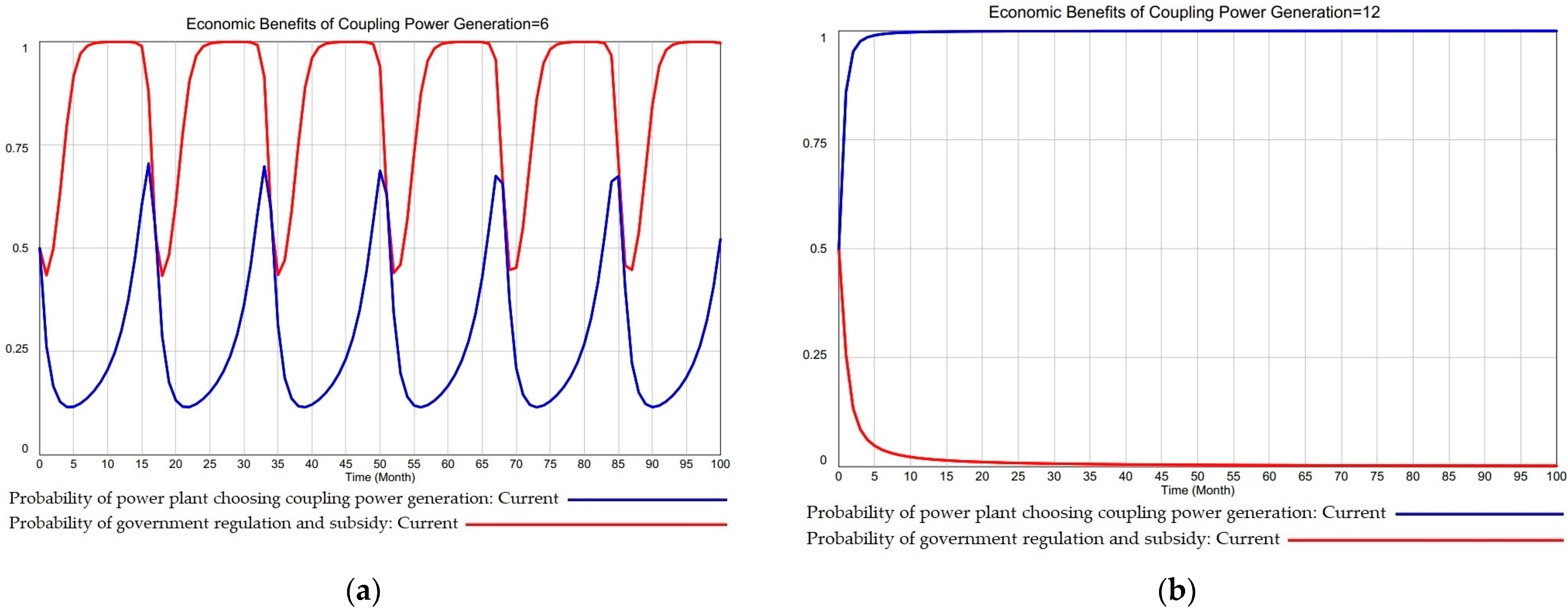Evolutionary Game and Simulation Analysis of Power Plant and Government Behavior Strategies in the Coupled Power Generation Industry of Agricultural and Forestry Biomass and Coal
Abstract
:1. Introduction
2. Evolutionary Game Model
2.1. Applicability of Evolutionary Game Theory
2.2. Game Players
2.3. Model Hypotheses
2.4. Model Construction
2.5. Analysis of the Evolutionary Game Results
2.5.1. Unilateral Strategy Analysis of Power Plants
- (a)
- When , then , , so ‘ is the equilibrium point. At this time, the power plant strategy is not to choose coupled power generation technology;
- (b)
- When , , so is the equilibrium point. At this time, the power plant strategy is to choose coupled power generation technology.
2.5.2. Unilateral Strategy Analysis of the Government
- (c)
- When , , , , so is the equilibrium point, the government will regulate and subsidize power plants;
- (d)
- When , , so is the equilibrium point. At this time, the government’s strategy is not to regulate and subsidize power plants.
2.5.3. Equilibrium Strategy Analysis of Mixed Evolutionary Game Model of Power Plants and the Government
3. System Dynamics Model Construction and Simulation Analysis Based on an Evolutionary Game
3.1. System Dynamics Model Construction
3.2. Analysis of Simulation Results
3.2.1. Initial Simulation Results
3.2.2. The Influence of a Government Subsidy, , on the Behavioral Strategies of the Players
3.2.3. The Influence of the Carbon Emission Charge, , Paid by Power Plants on the Behavioral Strategies of the Players
3.2.4. The Influence of the Economic Benefits, , of Coupled Power Generation on the Behavior Strategies of the Players
3.2.5. The Influence of the Indirect Benefits, , of Coupled Power Generation on the Behavior Strategies of the Players
3.2.6. The Influence of the Transformation Cost, , of Coupled Power Generation on the Behavior Strategies of the Players
4. Discussion
5. Conclusions and Policy Recommendations
- (1)
- In the process of the development of the coupled power generation of AFB and coal, the behavioral strategies of power plants and the government dynamically influence each other. The government’s subsidy strategies and regulatory measures for the coupled power generation industry will drive more power plants to choose it.
- (2)
- The government will increase the amount of policy subsidies and strengthen the punishment of coal-fired power plants, which will encourage more power plants to choose the coupled power generation of AFB and coal. Meanwhile, improving the economic benefits, increasing the indirect benefits, and reducing the transformation cost of coupled power generation can encourage more power plants to choose coupled coal power generation.
- (3)
- The government’s corresponding policy regulatory and subsidy measures can only change the enthusiasm of power plants to choose the coupled power generation of AFB and coal. In order to fundamentally enable power plants to independently choose it, it is necessary to increase the income obtained by the choice or reduce the transformation cost of coupled power generation.
Author Contributions
Funding
Institutional Review Board Statement
Informed Consent Statement
Data Availability Statement
Conflicts of Interest
References
- Mallapaty, S. How China could be carbon neutral by mid-century. Nature 2020, 586, 482–483. [Google Scholar] [CrossRef] [PubMed]
- Franke, K.; Sensfuss, F.; Bernath, C.; Lux, B. Carbon-neutral energy systems and the importance of flexibility options: A case study in China. Comput. Ind. Eng. 2021, 162, 107712. [Google Scholar] [CrossRef]
- Bongaarts, J. Intergovernmental panel on climate change special report on global warming of 1.5 °C Switzerland: IPCC, 2018. Popul. Dev. Rev. 2019, 45, 251–252. [Google Scholar] [CrossRef]
- Ma, X.; Wu, L.; Zhu, Y.; Wu, J.; Qin, Y. Simulation of vegetation carbon sink of arbor forest and carbon mitigation of forestry bioenergy in China. Int. J. Environ. Res. Public Health 2022, 19, 13507. [Google Scholar] [CrossRef]
- Wieruszewski, M.; Mydlarz, K. The potential of the bioenergy market in the European union—An overview of energy biomass resources. Energies 2022, 15, 9601. [Google Scholar] [CrossRef]
- Roni, M.S.; Chowdhury, S.; Mamun, S.; Marufuzzaman, M.; Lein, W.; Johnson, S. Biomass co-firing technology with policies, challenges, and opportunities: A global review. Renew. Sust. Energy Rev. 2017, 78, 1089–1101. [Google Scholar] [CrossRef]
- Aberilla, J.M.; Gallego-Schmid, A.; Azapagic, A. Environmental sustainability of small-scale biomass power technologies for agricultural communities in developing countries. Renew. Energy 2019, 141, 493–506. [Google Scholar] [CrossRef]
- Agbor, E.; Oyedun, A.O.; Zhang, X.; Kumar, A. Integrated techno-economic and environmental assessments of sixty scenarios for co-firing biomass with coal and natural gas. Appl. Energy 2016, 169, 433–449. [Google Scholar] [CrossRef]
- Dundar, B.; Mcgarvey, R.G.; Aguilar, F.X. Optimal multi-state partnerships for woody biomass co-firing incorporating a demand-response function for biomass procurement. Optim. Lett. 2022, 16, 821–844. [Google Scholar] [CrossRef]
- Askarova, A.; Zamorano, M.; Martín-Pascual, J.; Nugymanova, A.; Bolegenova, S. A review of the energy potential of residual biomass for coincineration in Kazakhstan. Energies 2022, 15, 6482. [Google Scholar] [CrossRef]
- National Energy Administration, PRC. The 13th Five-Year Plan for Biomass Energy Development. Available online: http://www.gov.cn/xinwen/2016-12/06/content_5143612.htm (accessed on 28 October 2016).
- National Energy Administration, PRC. Notice of the Ministry of Ecology and Environment of the People’s Republic of China on Carrying out the Technical Transformation Pilot Work of Coal-Fired Coupled Biomass Power Generation. Available online: http://zfxxgk.nea.gov.cn/auto84/201712/t20171204_3065.htm (accessed on 27 November 2017).
- National Energy Administration, PRC. Notice on the Publication of the Catalogue of Additional Fund Subsidies for Electricity Price of Renewable Energy (The Seventh Batch). Available online: http://www.gov.cn/xinwen/2018-06/17/content_5299251.htm (accessed on 17 June 2018).
- National Development and Reform Commission, PRC. Guiding Catalogue of Industrial Structure Adjustment (2019 Edition). Available online: https://www.ndrc.gov.cn/fgsj/tjsj/cyfz/zzyfz/201911/t20191106_1201659.html (accessed on 6 November 2019).
- National Development and Reform Commission, PRC. Supplementary Notice on Relevant Issues of Several Opinions on Promoting the Healthy Development of Power Generation from Non-Water Renewable Energy Sources. Available online: http://jjs.mof.gov.cn/zhengcefagui/202010/t20201015_3604104.htm (accessed on 29 September 2020).
- Liu, H.; Ye, C.; Zhao, Y.; Li, G.; Xu, Y.; Tang, Y.; Luo, G.; Wang, Q. Performance analysis of biomass gasification coupled with ultra-supercritical power generation system. Chem. Eng. Process. Process Intensif. 2022, 179, 109093. [Google Scholar] [CrossRef]
- Ouyang, D.; Han, Y.; Wang, F.; Zhao, X. All-iron ions mediated electron transfer for biomass pretreatment coupling with direct generation of electricity from lignocellulose. Bioresour. Technol. 2021, 344, 126189. [Google Scholar] [CrossRef]
- Kamari, M.L.; Maleki, A.; Nazari, M.A.; Sadeghi, M.; Rosen, M.A.; Pourfayaz, F. Assessment of a biomass-based polygeneration plant for combined power, heat, bioethanol and biogas. Appl. Therm. Eng. 2021, 198, 117425. [Google Scholar] [CrossRef]
- Cai, Y.; Tay, K.; Zheng, Z.; Yang, W.; Wang, H.; Zeng, G.; Li, Z.; Siah, K.B.; Prabakaran, S. Modeling of ash formation and deposition processes in coal and biomass fired boilers: A comprehensive review. Appl. Energy 2018, 230, 1447–1544. [Google Scholar] [CrossRef]
- Wang, X.; Rahman, Z.U.; Lv, Z.; Zhu, Y.; Ruan, R.; Deng, S.; Zhang, L.; Tan, H. Experimental study and design of biomass co-firing in a full-scale coal-fired furnace with storage pulverizing system. Agronomy 2021, 11, 810. [Google Scholar] [CrossRef]
- Krzywanski, J.; Czakiert, T.; Zylka, A.; Nowak, W.; Sosnowski, M.; Grabowska, K.; Skrobek, D.; Sztekler, K.; Kulakowska, A.; Ashraf, W.M.; et al. Modelling of SO2 and NOx emissions from coal and biomass combustion in Air-Firing, Oxyfuel, iG-CLC, and CLOU conditions by fuzzy logic approach. Energies 2022, 15, 8095. [Google Scholar] [CrossRef]
- Agbor, E.; Zhang, X.; Kumar, A. A review of biomass co-firing in North America. Renew. Sust. Energy Rev. 2014, 40, 930–943. [Google Scholar] [CrossRef]
- Truong, A.H.; Ha-Duong, M.; Tran, H.A. Economics of co-firing rice straw in coal power plants in Vietnam. Renew. Sust. Energy Rev. 2022, 154, 111742. [Google Scholar] [CrossRef]
- Yang, B.; Wei, Y.M.; Liu, L.C.; Hou, Y.B.; Zhang, K.; Yang, L.; Feng, Y. Life cycle cost assessment of biomass co-firing power plants with CO2 capture and storage considering multiple incentives. Energy Econ. 2021, 96, 105173. [Google Scholar] [CrossRef]
- Sugiyono, A.; Febijanto, I.; Hilmawan, E.; Adiarso. Potential of biomass and coal co-firing power plants in Indonesia: A PESTEL analysis. IOP Conf. Ser. Earth Environ. Sci. 2022, 963, 012007. [Google Scholar] [CrossRef]
- Nawaz, Z.; Ali, U. Techno-economic evaluation of different operating scenarios for indigenous and imported coal blends and biomass co-firing on supercritical coal fired power plant performance. Energy 2020, 212, 118721. [Google Scholar] [CrossRef]
- Ashizawa, M.; Otaka, M.; Yamamoto, H.; Akisawa, A. CO2 emissions and economy of co-firing carbonized wood pellets at coal-fired power plants: The case of overseas production of pellets and use in Japan. Energies 2022, 15, 1770. [Google Scholar] [CrossRef]
- Picciano, P.; Aguilar, F.X.; Burtraw, D.; Mirzaee, A. Environmental and socio-economic implications of woody biomass co-firing at coal-fired power plants. Resour. Energy Econ. 2022, 68, 101296. [Google Scholar] [CrossRef]
- Xu, Y.; Yang, K.; Zhou, J.; Zhao, G. Coal-biomass co-firing power generation technology: Current status, challenges and policy implications. Sustainability 2020, 12, 3692. [Google Scholar] [CrossRef]
- Lintunen, J.; Kangas, H.L. The case of co-firing: The market level effects of subsidizing biomass co-combustion. Energy Econ. 2010, 32, 694–701. [Google Scholar] [CrossRef]
- Nurariffudin, M.; Hashim, H.; Tin, L.C. Spatial biomass resource planning framework for co-firing under carbon policy scheme. Chem. Eng. Trans. 2018, 63, 445–450. [Google Scholar] [CrossRef]
- Xu, J.; Huang, Q.; Lv, C.; Feng, Q.; Wang, F. Carbon emissions reductions oriented dynamic equilibrium strategy using biomass-coal co-firing. Energy Policy 2018, 123, 184–197. [Google Scholar] [CrossRef]
- Tevapitak, K.; Helmsing, A.H.J.B. The interaction between local governments and stakeholders in environmental management: The case of water pollution by SMEs in Thailand. J. Environ. Manag. 2019, 247, 840–848. [Google Scholar] [CrossRef]
- Moledina, A.A.; Coggins, J.S.; Polasky, S.; Costello, C. Dynamic environmental policy with strategic firms: Prices versus quantities. J. Environ. Econ. Manag. 2003, 45, 356–376. [Google Scholar] [CrossRef]
- Li, B.; Geng, Y.; Xia, X.; Qiao, D. The impact of government subsidies on the low-carbon supply chain based on carbon emission reduction level. Int. J. Environ. Res. Public Health 2021, 18, 7603. [Google Scholar] [CrossRef]
- Galik, C.S.; Benedum, M.E.; Kauffman, M.; Becker, D.R. Opportunities and barriers to forest biomass energy: A case study of four U.S. states. Biomass Bioenergy 2021, 148, 106035. [Google Scholar] [CrossRef]
- Nasiri, F.; Zaccour, G. An exploratory game-theoretic analysis of biomass electricity generation supply chain. Energy Policy 2009, 37, 4514–4522. [Google Scholar] [CrossRef]
- Tan, Q.; Wang, T.; Zhang, Y.; Miao, X.; Zhu, J. Nonlinear multi-objective optimization model for a biomass direct-fired power generation supply chain using a case study in China. Energy 2017, 139, 1066–1079. [Google Scholar] [CrossRef]
- Zhang, X.; Luo, K.; Tan, Q. A game theory analysis of China’s agri-biomass-based power generation supply chain: A co-opetition strategy. Energy Procedia 2017, 105, 168–173. [Google Scholar] [CrossRef]
- Zhai, M.; Zhang, X.; Cheng, F.; Zhou, X.; Su, X. A game-theoretic analysis of the government’s role on the biomass supply chain construction. Int. J. Ambient Energy 2017, 38, 444–458. [Google Scholar] [CrossRef]
- Luo, Y.; Miller, S.A. Using game theory to resolve the “chicken and egg” situation in promoting cellulosic bioenergy development. Ecol. Econ. 2017, 135, 29–41. [Google Scholar] [CrossRef]
- Friedman, D. Evolutionary games in economics. J. Econom. 1991, 59, 637–666. [Google Scholar] [CrossRef]
- Alghamdi, F.; Tatari, O.; Alghamdi, L. Enhancing the decision-making process for public-private partnerships infrastructure projects: A socio-economic system dynamic approach. J. Eng. Appl. Sci. 2022, 69, 67. [Google Scholar] [CrossRef]
- Xing, Y.; Deng, X. Evolutionary game model study of construction green supply chain management under the government intervention. IOP Conf. Ser. Earth Environ. Sci. 2017, 94, 012059. [Google Scholar] [CrossRef]
- Mahmoudi, R.; Rasti-Barzoki, M. Sustainable supply chains under government intervention with a real-world case study: An evolutionary game theoretic approach. Comput. Ind. Eng. 2018, 116, 130–143. [Google Scholar] [CrossRef]
- Jamali, M.B.; Rasti-barzoki, M.; Khosroshahi, H.; Altmann, J. An evolutionary game-theoretic approach to study the technological transformation of the industrial sector toward renewable electricity procurement: A case study of Iran. Appl. Energy 2022, 318, 119083. [Google Scholar] [CrossRef]
- Chen, W.; Zeng, Y.; Xu, C. Energy storage subsidy estimation for microgrid: A real option game-theoretic approach. Appl. Energy 2019, 239, 373–382. [Google Scholar] [CrossRef]
- Kanwal, F.; Ahmed, A.; Jamil, F.; Rafiq, S.; Ayub, H.M.U.; Ghauri, M.; Khurram, M.S.; Munir, S.; Inayat, A.; Abu Bakar, M.S.; et al. Co-combustion of blends of coal and underutilised biomass residues for environmental friendly electrical energy production. Sustainability 2021, 13, 4881. [Google Scholar] [CrossRef]
- Juan, J.S.; Sy, C. Multi-objective target-oriented robust optimization of biomass co-firing networks under quality uncertainty. J. Sustain. Dev. Energy Water Environ. Syst. 2021, 9, 1080364. [Google Scholar] [CrossRef]
- Khademi, A.; Eksioglu, S. Optimal governmental incentives for biomass cofiring to reduce emissions in the short-term. IISE Trans. 2021, 53, 883–896. [Google Scholar] [CrossRef]
- San Juan, J.L.G.; Aviso, K.B.; Tan, R.R.; Sy, C.L. A multi-objective optimization model for the design of biomass co-firing networks integrating feedstock quality considerations. Energies 2019, 12, 2252. [Google Scholar] [CrossRef]
- Taylor, P.D.; Jonker, L.B. Evolutionary stable strategies and game dynamics. Math. Biosci. 1978, 40, 145–156. [Google Scholar] [CrossRef]
- Garces, E.; Franco, C.J.; Tomei, J.; Dyner, I. Sustainable electricity supply for small off-grid communities in Colombia: A system dynamics approach. Energy Policy 2023, 172, 113314. [Google Scholar] [CrossRef]
- Cebrucean, D.; Cebrucean, V.; Ionel, I. Modeling and performance analysis of subcritical and supercritical coal-fired power plants with biomass co-firing and CO2 capture. Clean Technol. Environ. Policy 2020, 22, 153–169. [Google Scholar] [CrossRef]
- Ko, S.; Lautala, P. Advanced woody biomass logistics for co-firing in existing coal power plant: A case study of the great lakes states. Transp. Res. Rec. 2018, 2672, 93–106. [Google Scholar] [CrossRef]
- Li, Y.; Yang, T.; Zhang, Y. Evolutionary game theory-based system dynamics modeling for community solid waste classification in China. Util. Policy 2022, 79, 101451. [Google Scholar] [CrossRef]
- Gao, X.; Xi, Z. Evolutionary game of government and enterprise pollution discharge behavior under combined measures. China Environ. Sci. 2020, 40, 5484–5492. (In Chinese) [Google Scholar] [CrossRef]
- National Energy Administration of China. Notice on Improving the Price Policy of Agricultural and Forest Biomass Power Generation. Available online: http://www.nea.gov.cn/2010-07/28/c_131097727.htm (accessed on 28 July 2010).









| Strategies of Power Plants | Strategies of the Government | |
|---|---|---|
| Local Equilibrium Point | det(J) | tr(J) | Nature |
|---|---|---|---|
| − | Instability | ||
| − | Instability | ||
| − | Instability | ||
| − | Instability | ||
| − | Saddle point |
Disclaimer/Publisher’s Note: The statements, opinions and data contained in all publications are solely those of the individual author(s) and contributor(s) and not of MDPI and/or the editor(s). MDPI and/or the editor(s) disclaim responsibility for any injury to people or property resulting from any ideas, methods, instructions or products referred to in the content. |
© 2023 by the authors. Licensee MDPI, Basel, Switzerland. This article is an open access article distributed under the terms and conditions of the Creative Commons Attribution (CC BY) license (https://creativecommons.org/licenses/by/4.0/).
Share and Cite
Yu, D.; Zhang, C.; Wang, S.; Zhang, L. Evolutionary Game and Simulation Analysis of Power Plant and Government Behavior Strategies in the Coupled Power Generation Industry of Agricultural and Forestry Biomass and Coal. Energies 2023, 16, 1553. https://doi.org/10.3390/en16031553
Yu D, Zhang C, Wang S, Zhang L. Evolutionary Game and Simulation Analysis of Power Plant and Government Behavior Strategies in the Coupled Power Generation Industry of Agricultural and Forestry Biomass and Coal. Energies. 2023; 16(3):1553. https://doi.org/10.3390/en16031553
Chicago/Turabian StyleYu, Dan, Caihong Zhang, Siyi Wang, and Lan Zhang. 2023. "Evolutionary Game and Simulation Analysis of Power Plant and Government Behavior Strategies in the Coupled Power Generation Industry of Agricultural and Forestry Biomass and Coal" Energies 16, no. 3: 1553. https://doi.org/10.3390/en16031553
APA StyleYu, D., Zhang, C., Wang, S., & Zhang, L. (2023). Evolutionary Game and Simulation Analysis of Power Plant and Government Behavior Strategies in the Coupled Power Generation Industry of Agricultural and Forestry Biomass and Coal. Energies, 16(3), 1553. https://doi.org/10.3390/en16031553







